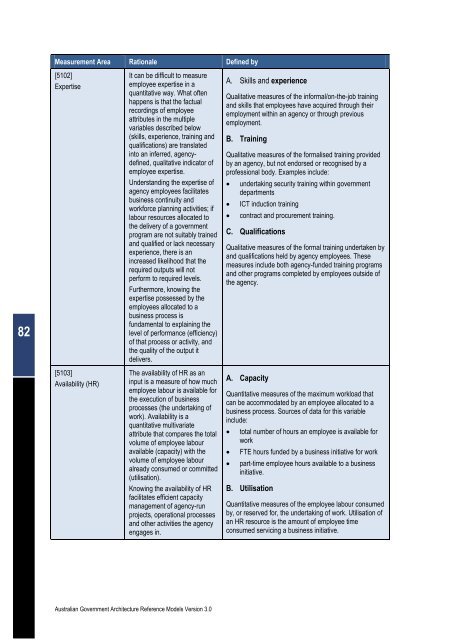Australian Government Architecture Reference Models Version 3.0
Australian Government Architecture Reference Models Version 3.0
Australian Government Architecture Reference Models Version 3.0
Create successful ePaper yourself
Turn your PDF publications into a flip-book with our unique Google optimized e-Paper software.
82<br />
Measurement Area Rationale Defined by<br />
[5102]<br />
Expertise<br />
[5103]<br />
Availability (HR)<br />
It can be difficult to measure<br />
employee expertise in a<br />
quantitative way. What often<br />
happens is that the factual<br />
recordings of employee<br />
attributes in the multiple<br />
variables described below<br />
(skills, experience, training and<br />
qualifications) are translated<br />
into an inferred, agencydefined,<br />
qualitative indicator of<br />
employee expertise.<br />
Understanding the expertise of<br />
agency employees facilitates<br />
business continuity and<br />
workforce planning activities; if<br />
labour resources allocated to<br />
the delivery of a government<br />
program are not suitably trained<br />
and qualified or lack necessary<br />
experience, there is an<br />
increased likelihood that the<br />
required outputs will not<br />
perform to required levels.<br />
Furthermore, knowing the<br />
expertise possessed by the<br />
employees allocated to a<br />
business process is<br />
fundamental to explaining the<br />
level of performance (efficiency)<br />
of that process or activity, and<br />
the quality of the output it<br />
delivers.<br />
The availability of HR as an<br />
input is a measure of how much<br />
employee labour is available for<br />
the execution of business<br />
processes (the undertaking of<br />
work). Availability is a<br />
quantitative multivariate<br />
attribute that compares the total<br />
volume of employee labour<br />
available (capacity) with the<br />
volume of employee labour<br />
already consumed or committed<br />
(utilisation).<br />
Knowing the availability of HR<br />
facilitates efficient capacity<br />
management of agency-run<br />
projects, operational processes<br />
and other activities the agency<br />
engages in.<br />
<strong>Australian</strong> <strong>Government</strong> <strong>Architecture</strong> <strong>Reference</strong> <strong>Models</strong> <strong>Version</strong> <strong>3.0</strong><br />
A. Skills and experience<br />
Qualitative measures of the informal/on-the-job training<br />
and skills that employees have acquired through their<br />
employment within an agency or through previous<br />
employment.<br />
B. Training<br />
Qualitative measures of the formalised training provided<br />
by an agency, but not endorsed or recognised by a<br />
professional body. Examples include:<br />
� undertaking security training within government<br />
departments<br />
� ICT induction training<br />
� contract and procurement training.<br />
C. Qualifications<br />
Qualitative measures of the formal training undertaken by<br />
and qualifications held by agency employees. These<br />
measures include both agency-funded training programs<br />
and other programs completed by employees outside of<br />
the agency.<br />
A. Capacity<br />
Quantitative measures of the maximum workload that<br />
can be accommodated by an employee allocated to a<br />
business process. Sources of data for this variable<br />
include:<br />
� total number of hours an employee is available for<br />
work<br />
� FTE hours funded by a business initiative for work<br />
� part-time employee hours available to a business<br />
initiative.<br />
B. Utilisation<br />
Quantitative measures of the employee labour consumed<br />
by, or reserved for, the undertaking of work. Utilisation of<br />
an HR resource is the amount of employee time<br />
consumed servicing a business initiative.

















